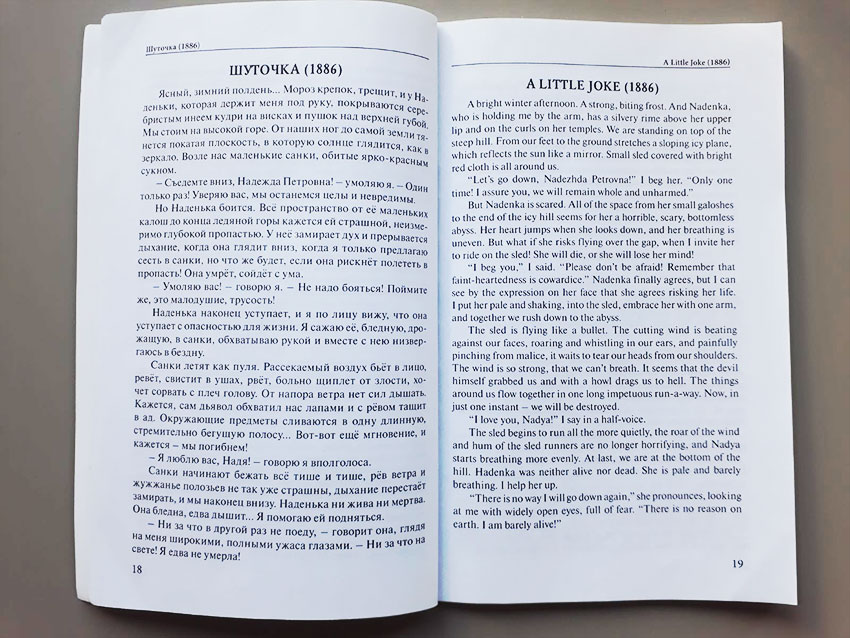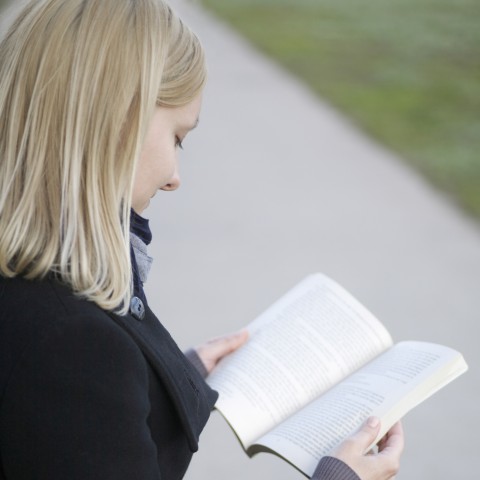How to Supercharge Your Vocabulary With Bilingual Reading

Reading in a foreign language is great. But if there’s one big fat problem, it’s that you need a high level of fluency before it gets fun. And if a book isn’t fun, then you’re not going to want to read it.
The entire point of sitting down with a book is to enjoy it and have a good time being absorbed in the story.
And that’s just not going to happen if you need to look up every second word with Google Translate or a real-life dictionary. It will take you out of the story and it will feel like a chore as if you’re back in high school and need to read the book to pass your curriculum.
I was literally shocked when my girlfriend brought me a collection of Chekhov’s stories that had Russian on the left page - and English on the right.
It’s such a simple and elegant solution that will make reading (especially at the beginner levels) so much easier and more fun.
I’m in the process of uploading Chekhov’s stories online, including an audio version, so that you can listen and read at the same time. You’ll find more resources down below (also for other languages).
So, what is bilingual reading?
It’s all in the name. You read a book in 2 languages. The language that you’re learning + the language that you’re fluent in.
There are several variants and the most common one is the picture below. You have a book that has your foreign language on the left, and English on the right. This is the more traditional form.
Now, online you can also find stories where the story is translated paragraph by paragraph. The same principle, just in more bite-sized chunks, so your eyes need to travel less to read both texts.
The great thing about bilingual reading is that you can quickly switch between languages. And that the translation already has been done correctly, so you won’t need to distinguish between the 10 variants of a translated word that your dictionary offers.
Which brings us to the main advantage…
It’s great for your initial vocabulary building
Look, the best way to improve your vocabulary is to learn words in context. Let’s say you’re reading a book in Spanish, and you read the following phrase:
El sol es caliente - the sun is warm.
Now your mind is making the connection between sun and warm. And it’ll be easier to remember that the word for “warm” is “caliente”.
The only problem with reading a book in another language is, like we said in the introduction, that you need a relatively high level of fluency before you can make this connection between words.
It’s great if you already know 80% of words, as you can deduct the meaning of another 10-15%, and only look up the remaining couple of words you do not understand.
But if you’re starting out, you might only know 10% of all words! That’s when bilingual reading can help a lot.
You’ll read the sentence first in another language. See if you get it and if you can puzzle what the meaning of some words is. Then you quickly glance on the other side of the page and see the translation.
This way you’ll be able to have fun reading AND learn contextual vocabulary at the same time
Why it works well if you’re learning a language at home
If you’re taking language classes, then your teacher basically takes on the role of the translated page. When you’re reading a text with your teacher, you can ask them questions whenever you do not get something. They’ll give you the correct translation quickly with another context on how the word functions in the sentence.
But if you’re learning from home you don’t have that advantage. Bilingual reading offers the same benefits, as you can quickly look up the translation of a sentence and see what each word means.
Stages how you can use bilingual books
The main goal of bilingual books is to breach the gap between the beginner and intermediate to advanced stages. They can help set you up to read real books, without any translation.
Some language purists might recommend you only read stories that were originally written in non-English, but I’d say that any book you enjoy goes well.
Here are the steps I recommend you go through:
- Stage 1 - simple bilingual stories (such as kids stories or fairy tales)
- Stage 2 - the same stories, but now only in another language
- Stage 3 - bilingual real books
- Stage 4 - real books
You can use bilingual reading to improve your vocabulary and reading understanding. Until you become so good that you don’t need it anymore.
Does it work for every language?
It doesn’t matter if you’re learning French, Dutch, Russian, Chinese or Indian, bilingual reading works for every language.
After all, the principles of language learning don’t change. Only the implementation does.
You also don’t really need too much knowledge at the start. If you like puzzling, then you could even start reading some simple bilingual stories without any prior experience in a language! (the only exception would be Russian, or any other language with different characters - in that case, you’d need to learn the alphabet first)
However, just as with other language programs and courses, the more people speak a specific language (and the more people want to learn it), the easier it will be to find bilingual books.
If you’re learning any of the big languages (Spanish, French, Russian, Chinese, Italian), then it’ll be easier to find translated stories that have been put into a bilingual format.
Which brings us to the final section…
Where do I find bilingual books?
There are many places to find them - and the internet has been a real game changer here. I’ve tried finding them in libraries, but you need a large library and quite some luck to find good (and more than just 1) bilingual books.
Here’s a list of resources:
- Language Lizard (all languages, physical books)
- Amazon also has a great selection
- The Fable Cottage (Children’s stories in Italian, French, German and Spanish)
I’m sure there are more places to find them. A quick google search with “dual language books + [language that you’re learning]” or “bilingual books + [language that you’re learning]” should be enough to show up some gems.
It’s really remarkable how easy and fun it can be to read a book in 2 languages. It will make learning a new language more of a fun activity, as opposed to a traditional lesson.
Here’s a final recap of the benefits:
- Learn new vocabulary quickly
- Make this vocabulary stick because you remember it in context
- Easier to put in more time into learning, as you enjoy the process
- Shortcut the path to reading real books
- A simple and fun way to learn at home without a teacher
Have you used bilingual books before in your language learning? Let it know in the comments!
Author: Arie Helderman started learning Russian in 2014. You can find which strategies worked best for him at Learn the Russian Language.
This entry was posted on Monday, March 11th, 2019 at 6:36 pm and is filed under Language Learning. You can follow any responses to this entry through the RSS 2.0 feed. You can leave a response, or trackback from your own site.



